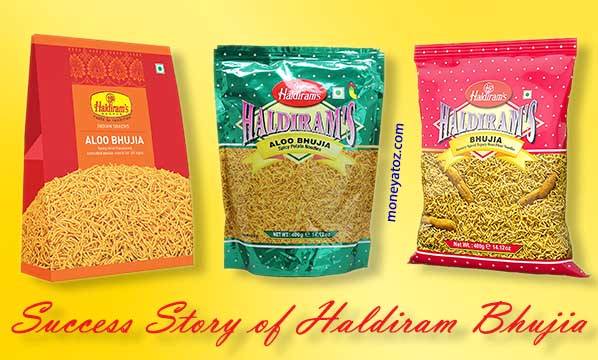Haldiram Bhujia - Journey from to Earth to Sky
A small shop opened before the independence of the country, which has now become India's number one snacks company, Know its success story
Haldiram's Snacks are available in almost every home. Even today, the namkeen served as a festive snack is incomplete without its products.
But did you know that Haldiram's began as a small shop before India's independence? After independence, such success flags were waved that the number one brand was founded.
Bikaner's Bania family's history

Haldiram with wife Champa Devi
The story starts with the Bikaner Bania family. Tansukhdas, whose low earnings were helping to sustain the family.
He was struggling to fulfill his family's responsibilities about 50-60 years before independence. His business was not able to earn respective income to satisfy the family need.
Tansukhdas has a son name Bhikharam Agarwal. Bhikharam after seeing the miserable condition of his family and business, planned to change his profession.
Opening of New Store
Then with his Bhikaram, Chandmal opened a small store called Bhikharam Chandmal. in that period people of Bikaner, Rajasthan had a strong tradition of eating Papad.
They also liked the taste of Bhujia Namkeen during the time.
They planned to sell bhujia namkeen as well. Bhikharam's sister, 'Bikhi Bai,' trained them how to make bhujia.
His sister learned how to make Bhujia at her in-laws' house. Bikhi would bring Bhujia to her maternal house whenever she visited.
That Bhujia was a favourite of his maternal relatives. Bhikharam, on the other hand, started to make Bhujia and selling it at his shop.
His bhujia, on the other hand, was as simple as the bhujia available at the market. In simple words, their livelihood was not in trouble.
Haldiram had always been a hard worker since he was a child..

Ganga Bishan Agarwal, his grandson, was born in Bhikharam's house in the year 1908. His name Haldiram was the nickname given by his mother.
His grandfather was only 33 years old, and his father was 18 years old when Haldiram was born. During that period of time early marriages were common.
Early marriages are still in practice in some parts of Rajasthan. Many cases come in the news of Early marriage Haldiram had seen Namkeen being made in the house since he was a child.
When he grew too young, he started supporting domestic and shop work. He was always interested in working.
His best feature was that he could rapidly learn any task with a lot of effort and dedication.
He quickly mastered the skill of making bhujia. Haldiram got married Champa Devi when he was only 11 years old. After marriage, responsibilities increased.
He went to his grandfather's Bhujia business and helped in running the shop. In comparison to the bhujia sold in the market, his bhujia was average.
So, this business was also not doing well. They wanted to expand Bhujia's business. They realized that the common taste of bhujia won't attract more customers, and their income is not going to improve.
They planned to do something different for this. In this case, Haldiram made various changes to improve the taste of his Bhujia.
He increased the share of moths in this way. That Bhujia was a hit amongst his customers. His bhujia was more delicious and unique in taste available in the market.
The number of customers was increasing day by day, and the company continued to expand over time. In the mid, he came to be disturbed by family disputes.
Haldiram finally took the decision to leave his family. From the family business, he got nothing.
The outcome of an experiment was life-changing.
Haldiram opened a small breakfast shop in Bikaner in 1937 after separating from his family.
After making a reputation in the market he also started selling Bhujia there as well. His continued experiment in Bhujia namkeen made him favourite among taste buds.
When demands increased he started producing on a cottage industry level. In the first, his name and fame spread in whole Rajasthan which made him India's great Bhujia namkeen brand in the course of the time.
Haldiram is said to have always done changes or experiments to improve the taste of his Bhujia.
His successor also keeps experimenting with new types of products. Now you can see varieties of delicious sweets used widely in India.
The empire begins...
The Haldiram empire began slowly as well. Haldiram visited Kolkata for a wedding, which inspired him to open a shop there.
That was the first step into the bhujia business in Bikaner. The business was not expanded further by the 2nd generation.
Grandsons Manoharlal and Shiv Kishan, on the other hand, expanded the firm to Nagpur and Delhi.
The Chandni Chowk store in Delhi was a big success with the residents. Following that, there were manufacturing facilities in Delhi and Nagpur, as well as restaurants in major Indian and international cities.
- Delhi-based Haldiram Snacks and traditional Foods in the Northern region,
- Nagpur-based Haldiram Foods International in the western and southern regions, and
- Kolkata-based Haldiram Bhujiawala in the eastern region,
The company was divided into three distinct areas of activity. The Delhi business has grown to become the most prominent.
Bhujia business is worth billions now.
Two of the company's three branches — Delhi-based Haldiram Ethnic Foods and its affiliates, and Nagpur-based Haldiram's Food International and affiliates — are now in negotiations with Kellogg's.
The two firms, excluding the restaurant business, are estimated to be worth around $3 billion (Rs 20,000 crore).
Together, the two divisions are estimated to generate revenues of Rs 4,500-5,000 crore and profit of Rs 450-550 crore in Financial Year 2019-20.
In the year 2016-17, Haldiram's revenues reached Rs 4,000 crore, more than doubling the size of Hindustan Unilever's packaged food division, Nestle Maggi.
It also beat the Indian turnover of the two American fast food rivals Domino's and McDonald's combined.
After more than two decades, Haldiram's claimed the top spot as the country's largest snack company in the year ended September 2017, beating PepsiCo in sales.
Haldiram's sales was Rs 4,224.8 crore in the fiscal year ended September, and PepsiCo, was Rs 3,990.7 crore, which includes brands like Kurkure, Lay's, and Uncle Chipps.
Conflict and dispute over a trademark

The business empire has been marked by breakups and disputes as Ganga Bhisan's successors fought over territory and trademark rights.
It is a common problem for legacy family-run businesses. The ownership of the brand and trademark is still a matter of dispute.
The bitterly divided Kolkata branch, which mostly works in West Bengal, has taken the other two sides to court. The Supreme Court is currently hearing the decade-long legal conflict.
A buyer will face a big challenge due to the company's complex corporate structure, which includes multiple subsidiaries and group units, as well as current disputes.
Journey of Bikaner Store to a French Bakery
When Ganga Bhisan opened his bhujia shop in Bikaner in 1937, he could hardly have imagined making it an empire.
Haldiram's also introducted :-
- Veg Shami Kebab,
- Soya Shami Kebab,
- Dahi Kebab, and
- Hara Bhara Kebab.
Haldiram's has grown from Ganga Bhisan's thin, moth-dal bhujia to a wide range of kebabs served throughout the Middle East as part of its frozen foods business..
In the meanwhile, it expanded its namkeen snack line to also include sweets like -
- Canned rasgullas
- Canned Gulab Jamun
- Soan papdi,
- pani puri,
- and now desi wraps.
Haldiram's has signed its first non-family partnership, an exclusive master franchisee deal with Brio, a French bakery cafe.
Kellogg's interest in Haldiram's?
The experience of Haldiram's shows that Western food companies, no matter how large, must go desi in order to become successful in the Indian market.
When the first McDonald's franchisee store in India opened in Basant Lok, Delhi, in 1996, it made a remarkable cultural adaptation.
It became the world's first McDonald's to not serve beef or pork products. Years later, the McAloo Tikki burger was introduced, marking another desi style food item.
The Big Mac eventually had to reincarnate as Mac Maharaja. Without offering vegetarian options, no foreign pizza chain can possibly succeed in India.
Subway, an American restaurant franchise, launched a Jain counter at its first all-veg store in Ahmedabad in 2013, marking the first move in this regard.
For international buyers, Haldiram's is an interesting alternative because it is impossible for a foreign food giant to develop a desi food brand from the ground up when desi brands can trace their family roots to 1937!
The most common factor in both Kellogg's and Haldiram's brand names is a telling coincidence.
Will Keith Kellogg of Michigan, like Ganga Bhisan of Bikaner, invented a food item called Corn Flakes more than a century ago.
The success of corn flakes allowed Kellogg's company to grow into a global giant. Kellogg's, which is negotiating a stake in Haldiram's, might be thinking that mixing corn flakes with bhujia might make for a hot combination.

